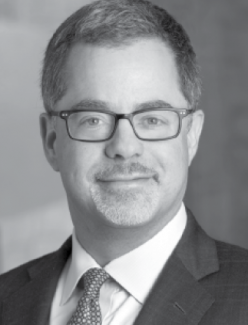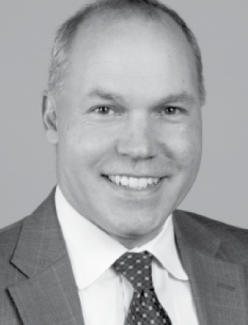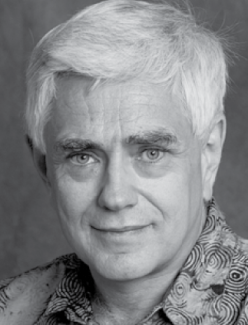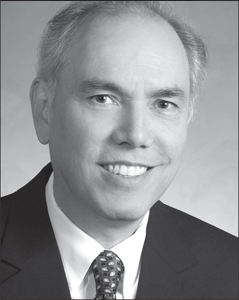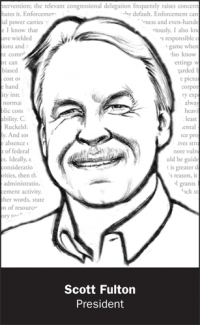The world is desperately behind in the energy transformation needed to avoid the worst impacts of climate change. Catching up requires a massive buildout of wind and solar power and associated infrastructure, but in the United States many impediments stand in the way. Among them, ironically enough, are environmental laws. Here I argue that we must accept difficult tradeoffs, sacrificing some of what we consider precious in order to avoid far worse impacts.
The Intergovernmental Panel on Climate Change says that avoiding catastrophic climate change requires keeping global average temperatures within 1.5 Celsius degrees above pre-industrial levels. In May, the World Meteorological Organization said there is a 50/50 chance that we will hit that level in just five years. We are now at around 1.2 degrees, and we are already seeing record-breaking heat waves, wildfires, droughts, and flooding; every added notch on the thermometer makes things worse.
According to the Climate Action Tracker, if all countries fulfill their latest pledges pursuant to the Paris climate agreement, the world will be between 1.7 and 2.6 degrees hotter by 2100. Unfortunately, many countries—including the United States—are far behind in meeting their pledges, and the actual policies and actions underway would take us to 2.0–3.6 degrees by the end of the century. Especially at the upper end of that range, such an increase would be an unimaginably terrible world, with large areas rendered uninhabitable and billions of people (that’s billions, with a “b”) displaced from their homes and looking for some place, any place, to live.
Every scenario for staying even at a fallback position of 2 degrees at century’s end includes the all-out construction of renewable energy projects, primarily wind and solar. The United States in particular needs a World War II-scale mobilization. That era saw a huge investment in research and development, and a nationwide commitment to meeting defense workforce and production goals.
This renewable energy is needed not only to replace fossil fuels in generating electricity, allowing the country to shut down all of its coal plants and almost all of its natural gas plants. Along with other countries, we also need to electrify transport, heating, buildings, and much of industry. U.S. electricity demand would about double, even after aggressive efforts to improve energy efficiency.
To get all this electricity from where it will be generated to where it is used, we also need a massive expansion of transmission—a tripling or quadrupling in capacity under some scenarios.
One attempt to quantify all of this was undertaken by Princeton University’s Net Zero America project in 2021. It sets forth several scenarios for the United States, of which only one does not rely on a large number of new nuclear power plants along with carbon capture and sequestration to allow continued use of natural gas for electricity. That scenario involves 3,085 gigawatts of wind generating capacity and 2,750 gigawatts of solar. This would require an estimated 4,000 square miles of land for the wind and 21,000 square miles for the solar (though much of this land could simultaneously support agriculture or other commercial or industrial uses). That adds up to about the land area of West Virginia.
The reason so much land is required is power density: it takes one or two orders of magnitude more acreage to produce a given amount of electricity with wind or solar than with coal, natural gas, or nuclear power, even considering the land disturbance to acquire their needed fuel.
Several studies conclude that achieving the needed level of wind and solar requires building on the order of 100 gigawatts a year out to 2050. To put this in perspective, one good-sized nuclear power plant, or a very large wind farm, has a capacity of about 1 gigawatt. So we would have to build the equivalent of around 100 of these every year.
The principal way to reduce the amount of new wind and solar required under these scenarios would be large-scale deployment of technologies that are not yet and might never be at a commercial scale. These include small modular nuclear reactors, fusion power, tidal generators, carbon capture, geothermal, or perhaps other energy sources that are not yet on the horizon. These may work out, and a great deal of research and development is being pursued, as it should, but we cannot assume success and relax other efforts.
The worsening projections about future climate conditions also mean that we will need to build more infrastructure to adapt to those conditions—sea walls, larger drainage systems, elevated buildings and roads, and much else. We may also need to build new cities and expand old ones to accommodate those who are displaced from drowning coastlines, parched lands, and forests that have become tinderboxes. This may be millions or tens of millions of Americans, without doing anything for the far greater numbers of people in other countries who will be displaced in large part because of historical emissions from the United States.
There are many impediments grounded in law to achieving this level of wind and solar and the needed adaptation infrastructure. Each one could become, if not a veto point, a cause of years of delay that can kill a project, or a specter that keeps it from serious consideration in the first place.
Local zoning and building codes are high on the list. So are various federal statutes—the Endangered Species Act and other species protection laws; the National Environmental Policy Act and its state equivalents, with all of their procedural intricacies; and the wetlands and coastal protections in Section 404 of the Clean Water Act. We also have the laws protecting public lands and marine habitat. Concerns of environmental justice communities and Indigenous peoples must be considered. Labor and human rights conditions along the supply chains must be addressed. Property rights and trade protections will play important roles.
Each of these factors is entirely legitimate. Each has its own strong constituency that understandably does not want to budge on its particular issues. But cumulatively they contribute to preventing us from building what is needed at the pace and scale essential to address the climate crisis. So do many other financial, engineering, labor, supply chain, and other considerations. When all this is added up, it is difficult to imagine how the United States can build the renewables capacity needed to come even close to our temperature targets.
The Inflation Reduction Act, which President Biden signed on August 16, provides for approximately $370 billion over the next decade in energy and climate spending, including tax credits that will make it much less expensive to build renewables and other elements of clean energy infrastructure. The law provides a great deal of money for agencies to hire staff or consultants to prepare environmental impact assessments and to process applications, but otherwise it does little to clear away the obstacles to all this construction. The deal between Senators Joe Manchin (D-WV) and Chuck Schumer (D-NY) that allowed the passage of the law also included the enactment this fall of separate “permitting reform” legislation; the inevitable fight over that bill will feature loudly competing voices on how much needs to be given to the fossil fuel industry, and what environmental procedures need to be relaxed in exchange for an easier path for clean energy.
This brings me to my point. Rather than climate denial, the environmental community has tradeoff denial. We don’t recognize that it’s too late to preserve everything we consider precious, and to linger in making decisions. Society has run out of time to save everything we want to save, and to mull things over for years. Had the emissions curves peaked and started falling in the 1980s, when an increasing number of scientists were trying to sound the alarm about climate change, we might not have been forced into these tough choices. But that didn’t happen; we squandered the time. We have to acknowledge that we need to be in an era of triage, where we save what we can but recognize that there are things we’ll have to give up.
The United States has a special obligation to accelerate the clean energy transition—we have the world’s greatest financial and technological resources, our per capita greenhouse gas emissions are much higher than those of almost any other country, and our cumulative emissions and consequent climate damage are still the world’s largest.
All this leads me to what will certainly be a number of very unpopular suggestions.
One of the things I’d like to put on the table for debate is that sometimes we need to intrude into the critical habitat of an endangered species if that habitat is where we need to put our wind farms, solar arrays, transmission lines to carry the power, or the mines to extract essential minerals for the manufacture of the new clean energy equipment. We should certainly look for sites with the smallest impacts and also strive to mitigate the impacts that remain. But if despite reasonable measures some birds, bats, or plants will die as a result of building the necessary clean energy projects, that is the hard choice we need to make. Because if we don’t make this choice, far more birds, bats, and much else will die from the ravages of climate change.
We will need to give up some scenic mountain and ocean vistas. It’s wonderful to look at unadorned nature, but the best places for wind turbines are where winds are strongest, such as on top of ridge lines or off the coasts. I would rather see wind turbines on the horizon than know that coastal cities are drowning and millions of acres of human and species habitat are flooded or on fire. The wind and solar facilities in the Princeton scenario could be visible from an area the size of Texas and California combined; if we are precluded from putting these turbines and panels anywhere that people can see them, we’re totally sunk.
We also need to find ways for NEPA to take a lot less than the current average of 4.5 years to go through the environmental impact statement process. (The first section of the New York City subway system was built in less time.) The average approval time for new transmission lines (without which many wind and solar farms are useless) now exceeds 10 years. EISs shouldn’t have to rival War and Peace in length.
We also need to re-examine the demand for local consent. My work has found that in nearly each of the 50 states, cities and towns have enacted zoning or building laws to block renewables. (That’s why in 2019 I founded the Renewable Energy Legal Defense Initiative, which provides pro bono legal assistance to community groups and others that favor wind and solar but that are facing local opposition.) We have to preempt a lot of these laws that block renewables—in other words, to allow a higher level of government to nullify restrictions imposed by a lower level. New York adopted a law in 2020 giving the state sole authority to approve utility-scale wind and solar projects; Albany needs to consider local restrictions but does not have to follow them. New York had adopted a prior law in 2011 on renewables siting, but no project was approved under that law until 2018. Since the enactment of the new law, New York has approved 17 projects; few required going against local restrictions, but the hanging sword of that possibility no doubt sped up some of the projects, as did other expedited procedures under the law. California adopted a similar law last summer.
We also can’t afford to spend years negotiating every project until everyone is happy. To meet our renewables targets, we will need to reform public participation (important as it is) to keep it from paralyzing clean energy development until some elusive form of consensus is reached. And while it may be desirable to compensate neighbors who suffer losses as a result of these projects, this should not be asymmetric; clean energy projects should not have to pay for their negative externalities while (in the absence of a carbon tax) fossil fuel projects do not.
So I think we need to have a serious conversation about what does and does not survive the triage that we must undertake. What do we absolutely, positively have to preserve regardless of everything, and what might we have to sacrifice? These are tough and painful choices. There is no objective, right answer. It depends on a series of normative judgments. We environmental professionals will not be the ones making those judgments, but we can influence them. At a minimum, when there is an important clean energy or climate adaptation project that has some negative impacts and we know how to block or delay it using the environmental laws we have mastered, maybe we should instead refrain from doing that, and get out of the way. When an agency official is curious about some possible obscure impact, maybe she shouldn’t insist that the environmental impact statement study it, and perhaps the courts should excuse the absence.
For many years much of my law practice included litigating against things like highways, landfills, and incinerators. I used to say that I never met an EIS that I couldn’t sue. But the worm has turned. The task before us now is to quickly build a massive amount of clean energy and climate adaptation infrastructure. For these sorts of projects, we need to set aside our tools of obstruction (though of course we should continue using them against fossil fuel projects that have clean substitutes).
This is not all about making sacrifices. The needed energy transition will confer many benefits in addition to slashing greenhouse gas emissions and helping to solve the climate crisis. It will also lessen the conventional air pollution that takes millions of lives globally every year, and the water pollution from many forms of fossil fuel extraction. It will reduce reliance on imported fuels and on the countries that produce them, such as Russia and Saudi Arabia. It will cut down the use of fuels whose prices can fluctuate wildly; high energy prices are one of the core causes of today’s inflation. It will create many jobs; according to the Princeton study, the all-renewables scenario would lead to a net increase of about five million jobs in the United States (after subtracting the jobs lost in fossil fuel industries— mostly gasoline station employees).
I think we also need to set aside a number of illusions about easy solutions that appear to be just around the corner but actually allow us to avoid tough choices such as those mentioned above.
In theory, we could create much of the renewable electricity capacity we need by putting solar panels on rooftops, parking lots, and similar surfaces. In reality only a small fraction of building owners, especially homeowners, will put panels on their roofs, certainly if they have to pay for it themselves up front. We can require new structures to have them, but there is little discussion of mandating their placement on existing buildings that are otherwise not undergoing major work. Cumbersome local approval processes also stand in the way. (In Australia, these installations can be approved online in as little as a day; in the United States it can take months.) Abandoned agricultural and mined land may have greater potential, if it is available for sale and otherwise physically suitable, and solar panels can be floated on reservoirs (“floatovoltaics”). So far at least, “distributed” solar costs around three times as much as utility-scale solar for the same generating capacity, so choices are needed about what to subsidize.
In theory, a price could be put on carbon that will percolate through the economy and transform our energy and consumption patterns; but in reality our political leaders are spooked by increases in the price of gasoline and electricity, and there is little if any indication that they’ll ever agree to impose a carbon price—certainly not one of the magnitude that economists say is necessary to do the job, despite protestations by advocates that the carbon revenues can be distributed in ways that can offset the pocketbook impact. The Inflation Reduction Act of 2022 demonstrates that Congress is all about carrots, not sticks—and not a single Republican member of the House or the Senate voted for even the carrots.
In theory, we could shut down our existing nuclear power plants even though they are operating well, and replace them with renewables and efficiency. In reality, whenever we’ve shut down a nuclear power plant, its electricity has mostly been replaced by natural gas. And much of the new renewables that have been brought on line aren’t able to aid in decarbonization since they’re having to stand in for a reactor that, until it was shut down, was a close to zero-carbon power source.
In theory, we could avoid having to build hundreds of millions of electric cars (with all the minerals needed to build them and the electricity to run them) by switching to mass transit and bicycles. In reality, mass transit and bicycles are wonderful in parts of some cities, but in few suburbs and almost no rural areas, where the densities are too low to support transit and the distances are too great for bicycles except for the hardiest (though the new generation of electric bikes certainly helps). There are many reasons to try to achieve greater densities (reducing racial segregation, improving affordability, consuming less land, encouraging physical activity through more walking and biking), but that is a campaign that has already been fought for decades and has its own withering battles with limited success. In sum, we can reduce the number of car trips, but there are real limits.
After Pearl Harbor, Congress gave immense powers to the War Production Board, and U.S. industry mobilized with stunning speed to produce the airplanes, tanks, and other materiel needed to win the war. But very few Americans were standing in the way. Indeed, the era saw unprecedented unity, and people of all kinds joined the war effort, including women and racial minorities who had previously been excluded from many roles. Unfortunately, today we have a major political party doing everything it can to block action on climate change. Anti-renewables organizations have sprung up, and right-wing media are amplifying their false messages.
Several academics have written about what we need to do to speed up the process. Among them are J.B. Ruhl, Jim Salzman, Jeff Thaler, Alexandra Klass, John Dernbach, Uma Outka, and John Ruple. Some of the suggestions that have emerged are more federal preemption of state and local control over renewables and transmission; more centralized decisionmaking, not just coordination, so that individual agencies can’t hold things up; broader allowance of mitigation when adverse impacts are found; and extensive use of eminent domain, especially for transmission lines.
We could have more use of programmatic EISs (which cover multiple similar projects, not just one) and regional assessments of species habitat and historic sites (necessarily accompanied by considerably greater agency staffing to do all of this) so that individual projects within the studied regions can move quickly. We should also adopt standard assessment and mitigation measures and permit conditions, so that the wheel doesn’t have to be reinvented and renegotiated every time, and impose tighter timelines for project reviews, with default approvals if those timelines are exceeded. Congress could provide for limits on judicial review, perhaps requiring all challenges to projects to be brought in the D.C. Circuit on the administrative record, with a short statute of limitations. Early engagement with disadvantaged communities, tribal governments and Indigenous peoples has also been found to be helpful.
A major challenge is that, in the hands of a pro-fossil fuel president or Congress, most of these tools could as readily be used to hasten the approval of dirty as well as clean energy projects. This further highlights the central importance of electoral politics in addressing the climate crisis.
We can’t afford any more obstacles. I think it’s incumbent on all of us who do understand the frightening magnitude of the climate threat to work to clear the path for the energy transformation we need.
There are some models of laws that have achieved speedy approvals for certain kinds of projects—the Telecommunications Act of 1996 for cell phone towers; the Defense Base Closure and Realignment Act of 1990; the Second War Powers Act of 1942. Whatever it is, I believe we need to move forward in this fashion, and not just plod along with business-as-usual environmental regulation toward a world of killing heat and mass human migration and species extinction. We need to end tradeoff denial. TEF
